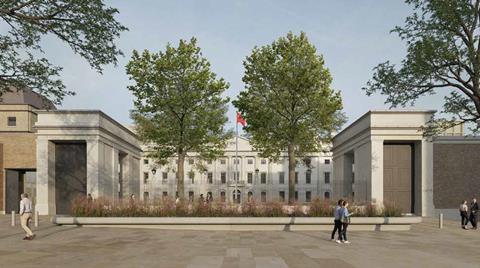David Chipperfield scheme would have seen complex swap Portland Place for Royal Mint site
Tower Hamlets council has rejected David Chipperfield Architects’ plans to convert the former Royal Mint site in East London into China’s new embassy over security and safety concerns.
Councillors voted three in favour and five against the planning officer’s recommendation to approve the scheme in a heated meeting yesterday evening.
The embassy would have been the largest in the UK, moving China’s London base from its current premises on Portland Place, opposite the RIBA headquarters, in central London.

But many residents and councillors were strongly opposed to the scheme, which they said would increase traffic congestion in the area and damage heritage assets.
Concerns were also raised that there could be a repeat of the incident at the Chinese Consulate in Manchester in October, when a protestor suffered injuries after being allegedly dragged inside the compound and assaulted by embassy staff.
Councillor Shafi Ahmed said the plans would have a “profound impact on the residents in every aspect of their lives”.
He said the Manchester incident “passed serious doubts on the Chinese government’s ability to control their [staff’s] conduct in the United Kingdom”, which he said was “clearly of deep concern for both residents and businesses in a borough where free speech and democracy are our core values”.
Ahmed also said the embassy’s decision to cancel a consultation meeting with residents in the immediate aftermath of the Manchester protests “indicates that this embassy has no intention to seriously engage with the residents on the issues which most matter to them”.
“We claim to be a council that listens to the residents but this is a spit in the face of that idea,” he added.
The Chinese embassy has been contacted for comment.
The plans would have required the partial demolition of some grade II-listed buildings on the historic five acre complex, which housed the Royal Mint between 1809 and 1967. The grade II*-listed Johnson Smirke building, designed by James Johnson and British museum architect Robert Smirke, would have been restored and used as the embassy’s main building.

Tower Hamlets’ planning officers had said the proposals were well-designed and would “deliver a high quality, well integrated, inclusive and sustainable place”.
The officers’ report added that the proposals would open up new views of the Johnson Smirke building and deliver “a new landmark building of true distinction and architectural quality” in the Cultural Exchange. Planning officers said that building would a “bold green/grey ceramic building with celadon-coloured glazing”.
Campaign group the Twentieth Century Society said the proposals would result in the loss of “unique 20th-century buildings which contribute to the architectural interest of the Tower of London Conservation Area”.
Planning officers said they recognised that two 1980s buildings on the site, Murray House and Dexter House, were “of some limited historic interest”, but said the buildings would not have enough heritage significance to merit the status of non-designated heritage assets.
They added that government heritage adviser Historic England supported the application.


























No comments yet